Bass Fishing Brush Piles| Fishing Brush Piles For Bass
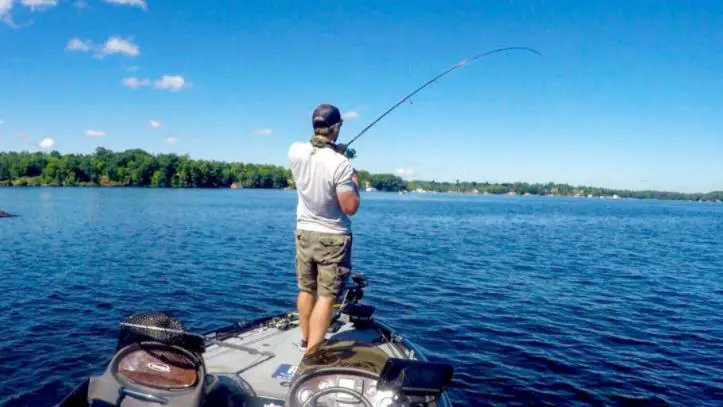
One thing is certain: not all brush piles are made the same.
The key to bass fishing brush piles are: (1) looking for certain sorts of brush piles that have a greater likelihood to hold fish; (2) knowing when to fish brush piles throughout the year; and (3) understanding what baits work best.
Occasionally, if you visit any large lake you’ll see tons of brush piles… and… choosing where to start is overwhelming! And to make matters worse, most of the brush piles you’ll encounter may have the occasional fish near them, but the majority will have no fish at all.
To be blunt with you there are only two ways to become successful with fishing brush piles.
The old way is to spend hundreds (if not thousands) of hours on the lake fishing every single brush pile you come across – just hoping to catch a fish. But… for the majority of us we don’t have the time or the money to waste going that route, right?
The new way is to fish the brush piles in a surgical systematic way that can instantly give you the green light to start fishing and catching bass!
Now take a second to think about this… Can you imagine yourself having the confidence to pull up to any brush pile and instantly know whether it can be fished or not? Can you see how many more fish you can catch in one day just knowing that? Wouldn’t that be awesome?
Heck yes it would!
Listen, If you ever got suckered into fishing at the wrong brush pile, you know it can be similar to being in a barren ghost town, wasting hours of your day, or forced to deal with a painful arm or back, or worse!
In our fishing blueprint, we’re going to help you avoid all that… let’s get started…
Key Takeaways
Thankfully, bass fishing has become second nature to me now… but that wasn’t always the case. As I spent thousands of hours watching and learning from my mentors, practicing hundreds of hours on the lake… only to fail horribly…
However, over years of honing my skill whenever I had the chance, I slowly started to create my personal brush pile fishing blueprint for beginners, which is kinda-like my private set of strategies and tactics. Now whenever I get to the lake I use my same blueprint and I can quickly pick out the best locations that are most likely to hold fish… which allows me to avoid wasting hours of my fishing day… would you like to know more? Great, here are just some of the things in this blueprint you’ll learn how to fish brush piles for bass:
- Understand what brush piles types are more likely to hold fish… and… which to avoid as fast as humanly possible!
- How your PC can get you extra bites when you’re on the water!
- How you can legally check to see if the brush piles attracts bass… even if the pile looks like the hundreds of others in the area… you will get your answer in less than 1 minute… and helps you avoid spending countless hours on the wrong fishing spot!
- The single best way fish a brush piles… this strategy will allow you to catch all the fish… never worry about spooking the rest… even if fish jumps off your hook!
- Learn the best one-two punch for making bass bite when your fishing brush piles – even Mike Tyson would be proud!
But be warned! Go through this blueprint slowly and carefully so you don’t miss any tips that could cost you.
Brush Pile Fishing Primer
Brush piles are fish-holding structures that provide covers for bait fish. It is a pile of wood or wood-like debris tied together, with a cement block used as its anchor. This structure is usually found around or under a body of water.
These brush piles are known to be strategic feeding spots for bass and crappie.
Fishing brush piles, although easy, require technicality and strategy. This article will uncover all there is to know about brush pile fishing.
Step 1: Understand the Different Types of Brush Piles
One thing to keep in mind is that the majority of these brush piles are artificial. Although, natural activities like wind, erosion, and the inflow of water can cause wood deposits to pile up, creating brush piles.
However, the rate of that happening is slow and becoming more and more slower due to development and human activity. Now, anglers create these brush piles and sink them at different spots in the water body to help increase their chances of getting a bite.
For this reason, there are various types of brush piles.
Helpful Tip: Most bass anglers tend to favor cedar brush plies because of durability.
They range from thick, scanty, horizontally placed, and vertically placed to shallowly situated and deeply situated.
As an angler, you could either fish in pre-existing brush piles or create your brush pile. Most bass anglers tend to favor cedar brush plies because of durability. This type of brush pile can simply be created by sinking a cedar tree top.
Brush piles are good spots for bass fishing as bass are almost always found in/around them. This is because these spots serve as a cover where bass can hide from their prey. Therefore, the bass is mostly found in brush piles during their feeding periods.
Step 2: Find Quality Brush Piles
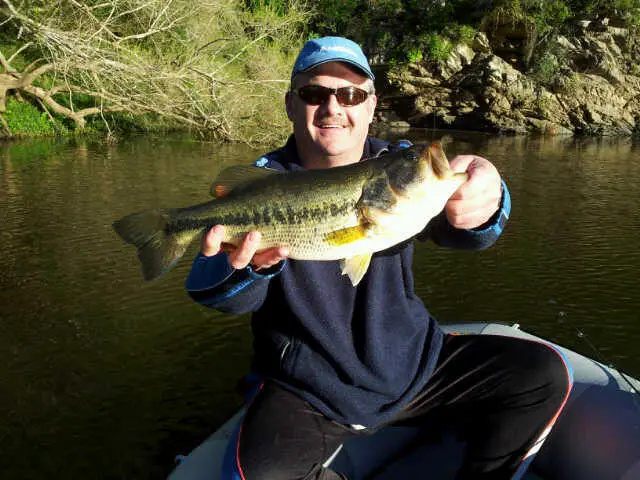
Unlike large topographic structures such as points, humps, or ridges, it can be very difficult to find brush piles on Google Maps or Google Earth because of their small size.
To make matters worse, you can’t find brush piles on Navionics either!
So what can you do next? Here’s the answer… find the best locations that are most likely to contain a brush pile.
Here are what I consider the 3 prime Brush Pile locations for beginners to fish… please note… there are more locations to learn, but I don’t want you to be overwhelmed. With that being said, if you’re going to be bass fishing brush piles, these have a better than average chance of holding bass. And they’re going to be:
- (A) Main lake points near deep water
- (B) Secondary points near channel swings
- (C) At the end of docks
- (D) Near or around marinas
(A) Main lake points near deep water
Brush piles planted on main lake points are seldom visible from the water or on a contour map because they are typically planted in 15-30 feet of water.
The best points tend to have at least one side dropping quickly into deep water. Points like this are magnets for bass and their prey.
(B) Secondary points near channel swings
Bass will also relate secondary points, although more commonly in the fall in the fall and spring.
In the spring, bass begin to migrate into the coves to spawn. They have a tendency to stage on secondary points near channel swings during the pre-spawning or spawning phase.
(C) At the end of docks
One of the best ways I learned to find brush piles are at the end of docks… and here’s a helpful tip… find a dock that has a lot of fishing poles lined up on the rails…
This means the dock is more than likely used often for fishing. Which could also mean the owner of the dock potentially planted brush underneath the dock to attract bluegill, sunfish, and crappie… This in turn then will attract bass and catfish.
(D) Near or around marinas
Saving my best tips for last, here it goes…
When I mention brush piles near marinas I know it can sound kind of vague, right?
Now hear me out…
If you take an angler who has a boat and frequently fishes the lake, or lives on the lake, but doesn’t want to go far to catch a fish, however want to give themselves the best chance to catch a fish, what do you think they’re going to do?
They’re going to put the odds in their favor and drop a few brush piles to attract those fish.
It gets even better…
Now, when you have a marina you have an area where many boaters also may have the same goal of catching a fish fast without traveling too far…
So now you have an location that has a bunch of fishermen launching from one area and those guys will plant brush piles all over the place… Sometimes my fish finder image looks like a Christmas tree because there’s so many stinking brush piles!
It’s been my experience that one of the best places to find a brush pile is around marinas.
So, as an angler who is new to the lake, if you have confidence in fishing brush piles, and you want to try to find brush piles, it’s easy to rule out the majority of the lake by targeting the marinas. Now you can quickly find submerged brush piles and other artificial structures that could attract fish.
Are you getting this? Is this making sense? I hope so, I should be charging money for the that tip.
Step 3: Identify the Brush Pile With Your Fish Finder
Scanning for brush piles is actually quite easy once you get on the water.
Step 1) I strongly suggest starting with a side scan first over the deepest section of the tip point or line of docks.
Step 2) Once you identify the brush pile, motor over it and scan it with your 2D sonar and structure scan looking for bait and bass.
Below is an example of how to scan for a brush pile.
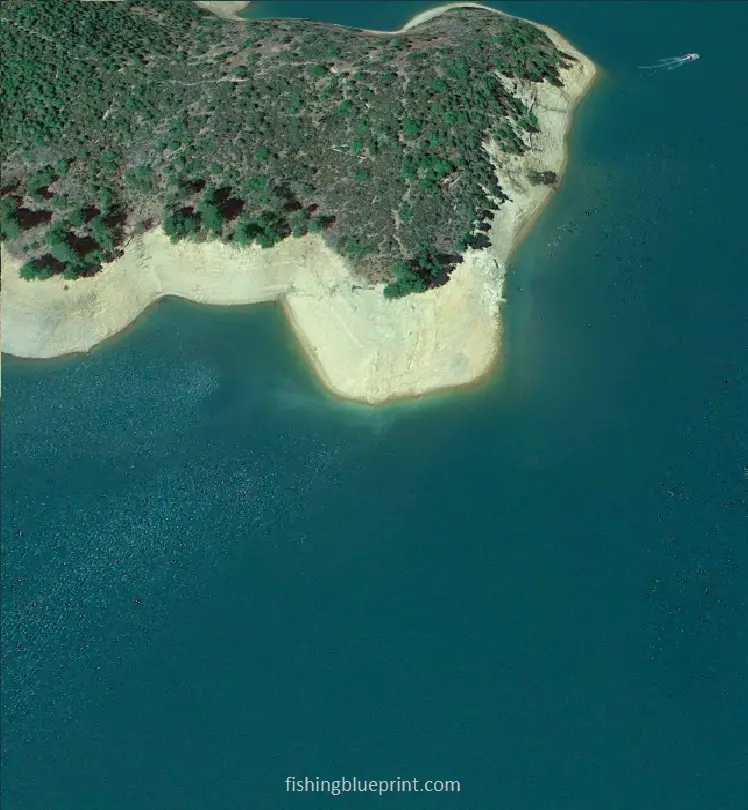
Now you did your homework and researched where to find the best brush piles. This example is a main lake point with a sharp drop into deep water.

So you get to the lake. Step 1 start side scanning the area…
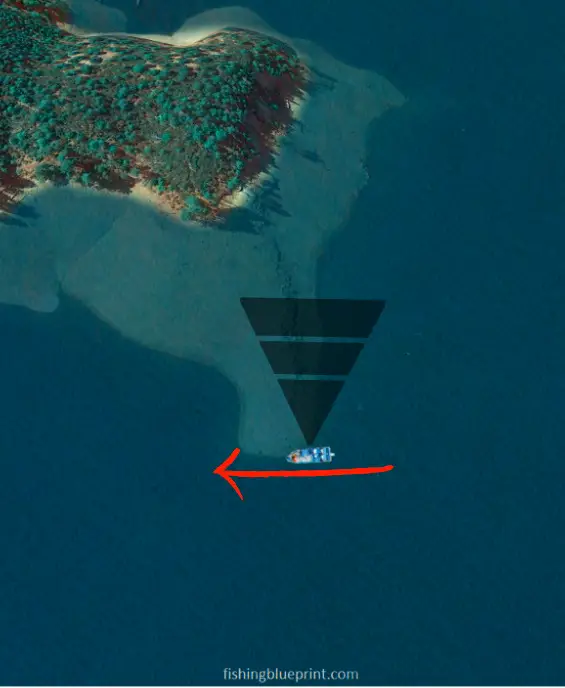
This is what it should look like with your side scan sonar (image below).
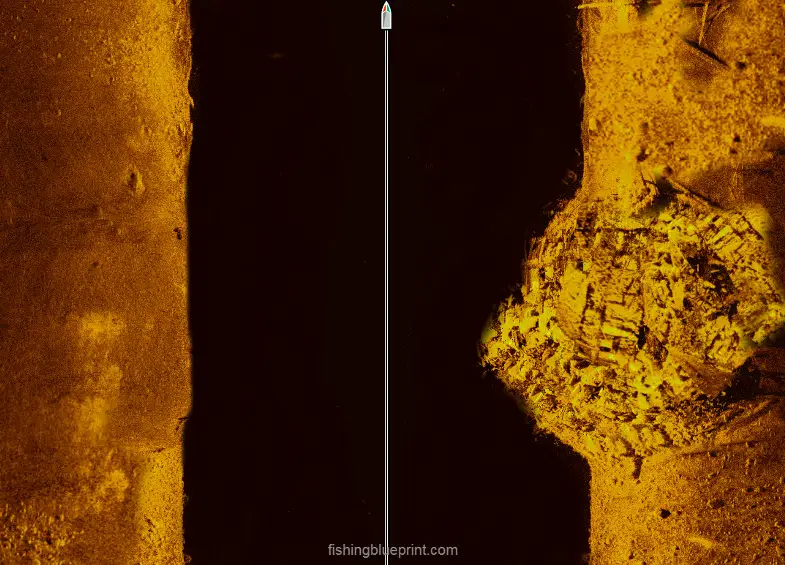
Your fish finder will also check the depth of water, water temperature, speed, and heading as you drive your boat over the lake.
If you see balls of bait you and the area looks like a good spot, then switch to you structure scan and 2D sonar
Start by driving back and forth over the brush pile.
Take note if there are any bait or bass that are located near the brush pile.
Schools of shad will appear like a group of small floating dots.
Bass will appear as arcs. Usually they are positioned in a horizontal line and do not stack up more than two or three fish above another one.
If you see more than 3 large arcs stacked on one another chances are they are crappie, white bass, or yellow bass.
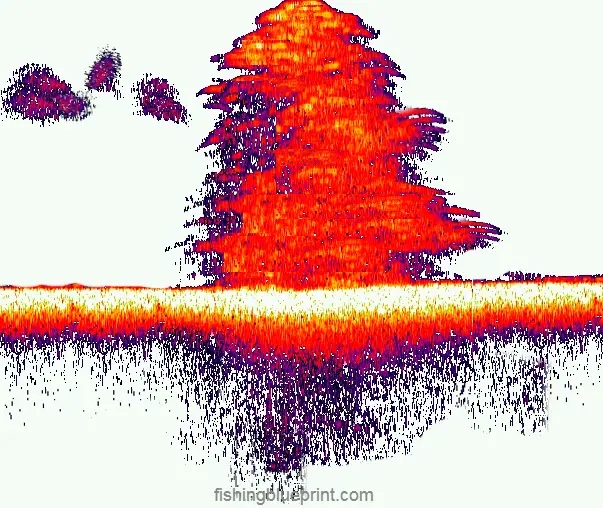
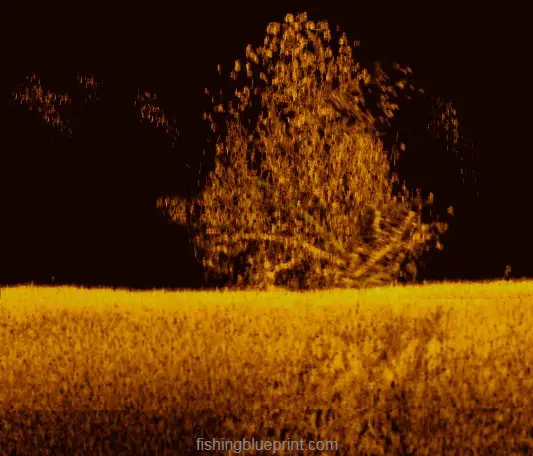
Finding Active vs. Inactive Fish
When scanning a brush pile you want to see the bass on top, or very close to is. This signifies the bass are actively feeding. These fish are extremely catchable anytime they are relating directly on top of brush pile, best of all you can typically catch them using an assortment of lures.
Look at the images below. This is a downward scan image I recreated to show you what bass look like when they’re relating to the apex of the brush pile, they are the large arcs. The smaller dots represent baitfish like shad.
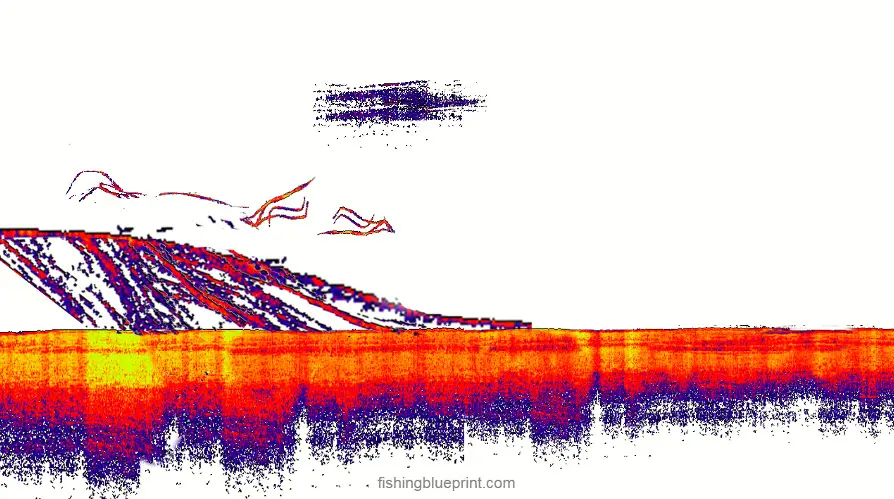
The bass will suspend above the deeper water, off to the side of the point are not actively feeding. As an illustration in the picture below, they are off to the side of the brush pile and are harder to catch.

Step 4: Fishing The Brush Pile Systematically
Below are some strategies for securing a sure bite when fishing brush piles;
1) Location, location, location. The right location is everything when fishing brush piles. Idle areas like docks, middle of coves, and points that we discussed earlier; these areas produce the most bass.
2) Mark the brush pile with a marker buoy 10-15 yards off to the side. And then make your cast. Once you catch a fish from the brush pile immediately drop another marker buoy or save a waypoint on your fish finder unit. That way after you land the fish you can line up the boat exactly how it was when you caught the first fish.
Helpful Tip: Ribbon-tailed worms, crankbaits, and swim baits are excellent baits to fish brush piles with.
3) Start with using a moving bait. Bass inhabit brush piles for feeding and during the pre-spawn period. For this reason, moving baits would easily draw the attention of the bass and lure them easily towards you. Ribbon-tailed worms, crankbaits, and swim baits are excellent for this purpose. Jigs can also suffice. You’ll need to move the bait up and down in a yoyo-like motion to catch the attention of the bass.
4) To get the attention of the bass faster, run the bait through the brush. You need to do that very carefully and slowly though to prevent a hang-up. When doing this, you can go for a slow sinking bait. Make a long cast, allowing your bait to sink to the bottom. Then, drag the bait past the brush.
5) Slow it down to pick off the more reluctant bass. If you’re not getting any bites from the fast moving baits it will be time to slow it down. When you do this you’ll not only be fishing on the sides and the top of the brush pile, but down deep in the middle of it.
My hats off to Justin at Fish The Moment YouTube channel, he has taught me so much when it comes to offshore brush pile fishing. From watching and learning what he does, he likes to use a football jig. And while this gave me some success, I really have the best success when I use a tungsten flipping jig. Here’s why…
Tungsten is a denser material than lead which means you get a heavier weight in a smaller package. Tungsten is nearly twice as hard than lead, and is about ½ the size of a lead jig,
The smaller sizes also means less drag… which also means it has a quicker fall rate for the same sized lead jig.
Lastly, since it’s more compact there is less chance for hangups.
My second or third choice for baits are going to be Texas rigged compact soft plastic creature baits for flipping, or even 4 or 5 inch stick baits are great for penetrating the thickest of brush piles without getting hung up.
And yes, I’ll thread on a tungsten bullet weight for the same reason that I outlined above.
6) And finally, be stealthy. During the process of checking the brush pile to see if there are bass around it and casting your bait, try to be as quiet as possible. You might not necessarily have to be quiet, but let the noise be steady. Do not rev your engines and maintain a steady rpm.
Step 5: Picking the Best Baits For Brush Pile Fishing
Your fishing trip might succeed or fail based upon your choice of baits. After learning from some of the top anglers in the world and spending years fishing brush piles, I devised and formed the best brush pile fishing baits into a simple method… and… I still employ it now!
I start with reaction baits to pick off the most aggressive bass. The baits I know work are; soft plastic swimbaits, umbrella rigs, and deep-diving crankbaits.
Then I’ll switch between a flipping jig, soft plastic creature bait, Texas rigged large (10+ inch) worms, and a Senko after the feeding frenzy begins to quiet down.
If you’re good at fishing lake bottoms, you might want to try alternative slower presentation techniques like the shaky head, weedless wacky rig, or weedless drop shot.
Fast fishing is typically the best method since it keeps the fish interested and increases the likelihood that they will attack your bait.
When Is The Best Time of the Day to Fish Brush Piles
Bass will always favor brush piles. For this reason, bass can be found in/around brush piles all year long. However, it’s best to fish brush piles at the early dawn or dusk. But the bass will be active on brush piles throughout the day as well, normally between 10-and-2pm.
My Personal Notes: My 2 Biggest Problems with Fishing Brush Piles
The most common problem I faced when I first started fishing brush piles is finding brush piles. Locating brush piles takes a lot of time and effort. You can spend long hours trying to scan an entire lake in search of brush piles. Here are a few tips to help speed up the process of finding a brush pile;
- First thing is to get a fish finder; It doesn’t matter what brand. Fish finders would make it easier for you to detect brush piles. Additionally, side imaging and down imaging would help you locate the brush pile faster and better than the traditional 2d Sonar.
- A good place to search for brush piles is docks. You can look for simple clues like rod holders or lights. This often indicates that a fisherman lives close by and that there must be a brush sunk somewhere around there.
- Next, you should try determining the lake’s thermocline level. Doing this would help you know the right depth.
Helpful Tip: A good place to search for brush piles is docks. You can look for simple clues like rod holders or lights. This often indicates that a fisherman lives close by and that there must be a brush sunk somewhere around there.
Other common problems are hang-ups and loss of lures. Many anglers tend to avoid fishing for bass in brush piles because of hangups and snags. It can be very frustrating having to replace lures after each cast and this is a very common issue with brush pile fishing. Here are a few tips to help prevent frequent snags and hang-ups;
- Avoid casting hurriedly. Instead, try going in slowly as this would help you tell where obstacles are, making it easier for you to avoid them.
- Try pulling vertically instead of horizontally. Pulling horizontally will be going right into the brush and that will get your line tangled up fast.
- Avoid casting directly into crappie brush. Crappie brushes are positioned differently from bass brushes. Crappie brushes tend to cause a lot of hang-ups. As a bass angler, you should try to determine the nature of the brush before going for the catch.
- Try using monofilament lines over fluorocarbon. This is because monofilament lines offer more stretch.
- Don’t cast from far away. You should try to determine the right distance to cast from; not too close and not too far. If your cast is too long, the chances of getting your bait snagged are higher. This is because you might end up pulling your bait right into the brush.
- Since the majority of brush piles are artificial, the other brush piles in the particular body of water are likely at similar depths. This is because lake managers tend to drop brush piles at a certain depth at different points in the water body.
Want To Learn Where To Catch More Bass? Checkout These Articles...
- Bass Fishing CREEKS The Easy Way (In Less Than 10 Minutes)
- Warning: Bass Fishing HEAVY GRASS? [15+ Mistakes To Avoid]
- Bass Fishing POINTS in 5 Quick & EASY Steps!
- Complete 5-Step DOCK Fishing Formula
- Bass Fishing LAYDOWNS [Complete Guide + Pictures]
- Little Known Pattern for Fishing TREES for Bass.. Now and Forever
- Complete Formula For BASS FISHING ROCKY BANKS & RIPRAP
- The 5 TRUTHS about Bass Fishing BRIDGES and Avoid Wasting Time On Techniques That Don’t Work!
- Bass Fishing BRUSH PILES To Catch The Most Bass In Minimum Time!
- The 7-step Secret Formula for Bass Fishing LEDGES – Even a Complete Fishing Noob Can Use and Be 100 Times More Potent Than the Best B.A.S.S. Professional!
- The Single Best Guide to Fishing SHELL BEDS… and… Do It Fast!
- 5 Basic Elements Of Fishing HUMPS AND RIDGES No One is Talking About!
- 5 Crucial (and Unusual) Tactics You Must Do When Bass Fishing ROADBEDS!
- Top 25 Summer BANK Fishing Tips (Never Get Skunked Again)
- [EXPERT REVEALS] Bass Fishing In MUDDY WATER Secrets – 27 Tips & Mistakes To Avoid Today!
- 31 Best Tips for Bass Fishing At NIGHT (Complete Guide)
Other Bass Fishing Articles Just For You...
Funny Fishing Rules, Laws, and Regulations 2025
Crazy Fishing Laws That Will Blow Your Mind! #7 is INSANE! Strange Fishing Regulations and Laws As silly as hook and rod limits may seem,
EXPOSED! How To Use A Spinnerbait The Right Way for 2025
Are You Wondering How To Use A Spinnerbait? Or How To Work A Spinnerbait Over Grass, Logs, or Points? Well, All These Questions Are Answered
EXPOSED! Best Crankbait Colors for 2025 [Which to Buy & Avoid]
What color crankbait to use? Crankbait Color Chart I just love going into a Bass Pro Shops store and just staring at all the walls
Best Underwater Dock Lights For Fishing – 2025 Buyers Guide
Night Dock Light Fishing For Beginners Dear fellow angler, Does this sound like you? You’re someone who loves fishing but just wants to escape the
15 Best Deep Diving Crankbaits [2025 Buyers Guide – Which to Buy & Avoid]
A Complete Buyer’s Blueprint On The Best Deep Diving Crankbaits for Bass, Walleye, or Striped Bass On The Market Today Fishing deep diving crankbaits can
